This week, we look back at more of the very best bits of Naked Science. We find out why scientists are swollen with success after discovering spider venom with Viagra-like properties, We meet a cow that produces skimmed milk straight from the udder, we remember a way to improve brain function and ask if a hot mint will still taste cold? Also - It's curtains for us! Joel Veitch explains why we should measure hazardicity in 'Curtains', we hear about some very clever birds who make plans for the future and we probe the hole in the ozone layer. Plus, we have two of the best kitchen science experiments - finding out how to make a jar of dry rice sticky, and if a beer belly can stop a bullet!
In this episode
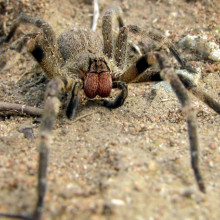
Scientists Swollen with Success
Researchers have uncovered a natural Viagra-like chemical in the venom of a Brazilian 'wandering' spider, Phoneutria nigriventer...
Kenia Pedrosa Nunes, Romulo Leite and colleagues, from the Medical College of Georgia, followed up on anecdotal reports that male victims bitten by the spiders subsequently developed a sustained erection.
Analysing the components of the venom one by one they uncovered a small protein, known as Tx2-6, capable of recreating the effect in male rats. Tests on the animals shows that the protein works in a novel way compared with drugs like Viagra.
The venom boosts the levels of an important vascular signalling molecule called NO (nitric oxide), which causes bloods vessel to relax and open up. It might therefore hold the key to managing a range of vascular disorders as well as impotence.
The scientists also suggest that if given with other drugs, like Viagra, it could help to magnify their effect. According to Leite, "the combination of the two drugs could be even more efficient in patients that don't respond well to Viagra..."
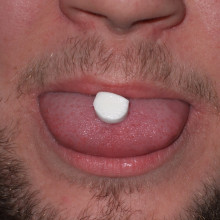
03:49 - Why do mints make your mouth feel cold?
Why do mints make your mouth feel cold?
US scientists have unlocked the secret of how the nervous system senses low temperatures, discovering in the process why sucking a mint makes your mouth feel cold.
Writing in Nature, David Julius, from the University of California San Francisco, found that mice lacking a gene called TRPM8 ceased to react to low temperatures. When offered a choice of a warm or cold surface, the TRPM8-deficient mice would spend significantly longer sitting in the cold than normal control animals.
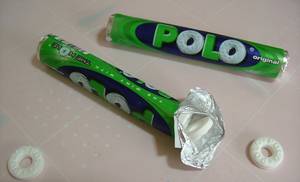
The missing gene encodes a pore which sits in the membrane of a specific class of cold-sensitive nerve fibres. When the nerve is cooled down the pore changes shape, triggering the production of excitatory nerve impulses that are relayed to the brain. The pore is also activated by menthol, which provokes the pore to change shape at much higher temperatures than it would normally, explaining why sucking a mint makes your breath feel cold against the back of your mouth.
But "Polos" making your mouth cold isn't the "hole" story because the mice weren't entirely cold-insensitive. Taking the temperature down below 10 degrees C resulted in an increase in nerve activity again, suggesting that there might be a further "extreme cold" receptor waiting to be discovered, or that at these low temperatures the physical damage done to tissue is enough to trigger other pain pathways.
Either way, researchers hope that by understanding the workings of these sensory nerve pathways they will be able to design better drugs to block pain syndromes including those triggered by exposure to the cold.
Now That's What I Call a Brainwave
Electrically stimulating the brain while it sleeps can boost memory formation, scientists have found. Writing in this week's Nature, University of Lubeck researcher Jan Bonn describes how he and his team recruited medical students and gave them a list of word-pairs to learn. Wires were attached to the students' heads and when they subsequently slept they received electrical stimulation designed to augment the natural slow wave brain activity seen when a person first nods off. Compared to when the students received "sham stimulation", in other words wore the electrodes but received no stimulation, subsequent recall amongst the stimulated subjects improved significantly. But the effect disappeared if the stimulation was delivered towards the end of a night's sleep. Jan Bonn thinks that the memory-boosting effect occurs because it encourages "replay activity", when a region of the brain called the hippocampus replays things learned during the day so that they can become consolidated into long term memory. Previously researchers had believed that these slow brain waves were an insignificant side effect of brain activity.
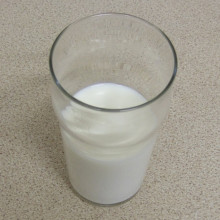
Does milk affect stamina?
If you drink milk that isn't skimmed, it's got lots and lots of fat in it. Having lots of fat isn't good for you because of the calories, but also because it furs up your blood vessels. Milk is also very rich in calcium which, in people who are prone to stones, can deposit in the kidney and cause kidney stones. And the other side effect of milk that not many people know, is if you have irritation to the stomach lining and you're at risk of getting stomach ulcers, calcium is used as a co-signal by the wall of the stomach to produce acid. If you have calcium levels in the blood going up, you make more acid. Some people think when they have a dodgy stomach that drinking milk will settle it. When you first do that your stomach feels happier because you've given the acid something to eat other than the wall of your stomach. But then the calcium is absorbed and goes into the blood stream and increases the amount of acid your stomach makes, causing a vicious cycle.
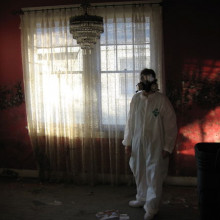
10:48 - It's GigaCurtains for us!
It's GigaCurtains for us!
with Joel Veitch, Rathergood.com
Last year, Joel Veitch of Rathergood.com wrote to New Scientist magazine with a suggestion for a scale of 'Hazardicity', measured using a unit he defined as the Curtain...
Joel - I did notice that people were starting to talk about nanohazards and whether there should be warning signs for them and that sort of thing. It struck me that really no one has defined what a nanohazard actually is because it turns out that there is no SI unit for the measurement of hazard. An SI unit is, like a metre is the SI unit of length, for example.
Chris - So what are you proposing?
Joel - Well, I had a look into the statistics, because without statistics science is nothing, and I thought that really what we should do is find something which poses a decent amount of hazard to a large number of people. Having looked through I realised that curtains, which are something that, of course, most people are exposed to on an almost daily basis...
Chris - What sort of curtains did you have in mind?
Joel - Actually, it's non-specific, it's any kind of curtain. So if you have curtains in the home then this is a hazard which applies to you, obviously. Looking at the statistics for 2002, they actually caused 4080 injuries in one year.
Chris - So what, people closing them, opening them? This is a classic joke when someone goes to the doctor and says: "Doctor, doctor I feel like a pair of curtains" and the doctor says "Pull yourself together!" This is what I'd like to say to whoever did this survey!
Joel - It doesn't specify the kinds of injuries. I mean, one can only guess, but it does specify an awful lot of other things that can cause injuries and I hate to imagine what those injuries might be.
Chris - I had a look at the Royal Society for the Prevention of Accidents' [RoSPA] website, on which they publish some of these details, and not surprisingly 'Building and DIY' causes about a million accidents a year nationally. But then I had a look further down, and looking at this, bread bins are actually lethal - 185 people a year are injuring themselves on bread bins! We need some kind of warning and regulation on bread bins!
Joel - It's true, we should, we should! And interestingly, having another look through there, you will see that some things which you would have thought would be inherently evil are, in fact, quite benign.
Chris - Well compasses and dividers, you know a compass has nice big pointy spikes on it, the kind of things that teachers would like to ban from classrooms; Zero accidents last year. We need people injuring themselves with these things so that we get them banned.
Joel - It's true... A mincer - just one accident with a mincer, and again with a mangle. [laughs]
Chris - Well paper clips apparently caused 62 injuries last year, which is devastating, maybe we should ban those?
Joel - Maybe we should, I've never found them terrifying myself...
Chris - Returning to the curtain issue, what did you propose that we should do in terms of coming up with some kind of nomenclature and unit of risk?
Joel - Well yes, assuming that we actually need a unit for the measurement of hazardicity, or risk as we could say, I would say the risk posed by a curtain over one year, being substantial as we now know, should be the unit of measurement. So one Curtain would be that amount of risk. Then we could measure the risks posed by other things in relation to their hazardicity compared to curtains.
Chris - So building and DIY would be like a Megacurtain?
Joel - Yeah, or possibly even a Gigacurtain!
Chris - Do you remember when you used to go to the theatre and they would have a smoking curtain?
Joel - Yes.
Chris - Well that's going to go out on the 1st of July, which is a bit of a shame really [although it will no longer pose a risk to theatre goers]. Vacuum cleaners cause 10,000 injuries every year - perish the thought why, if people didn't hoover naked I suppose it wouldn't happen, but on your scale that would be roughly 2 Curtains of risk?
Joel - Yeah, just over 2 Curtains.
Chris - So what's a really small risk?
Joel - One good example would be an artists brush.
Chris - How harmful is that?
Joel - In fact, that it how sensitive the data set is. By that I mean that the data we've got only goes down to one accident per year in the UK, or in fact 21 as it's only one in 21 people covered by the survey. There's only 60 million people in the country, which means that you can't have literally every possible hazard, because if there's no one injured by something in this country, then it doesn't figure on the stats.
Chris - You can't quantify it.
Joel - Exactly. So we can go down to, for example, an airbed poses a risk of exactly one Centicurtain, pretty much. So one hundredth as dangerous as a curtain.
Chris - How do you injure yourself with an airbed? It takes a bit of imagination.
Joel - Well, I imagine it's something to do with bouncing. Although, I have gone a bit faint trying to inflate them myself. I can see how that can result in a falling over incident...
Chris - So what do you think are the chances of Downing Street embracing your proposal and having a warning system based on the Curtain level of risk?
Joel - Well I think that depends on how much of a fuss we kick up really, doesn't it?
Chris - Are you going to take this to the House of Commons?
Joel - Well we should, it occurs to me that we have a new premier coming in, so maybe we should give him the opportunity to show his mettle.
Chris - This government is really quite into regulations and things, aren't they? I also noticed that on RoSPA's website that a real hot spot for accidents and damage is in cemeteries, which I think is quite appropriate really. You're in the right place to injure yourself because if it's really fatal you can just fall into a hole and that's that.
Joel - [Laughs] Yeah, I suppose so!
Chris - Thank you very much Joel, it's been really good to have you on the programme.
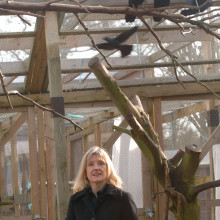
15:41 - Clever Birds - How Scrub Jays Plan for the Future
Clever Birds - How Scrub Jays Plan for the Future
with Professor Nicky Clayton, University of Cambridge
Chris - I'm very pleased to welcome Nicky Clayton from Cambridge University. Now Nicky you work on scrub jays, I understand that's a kind of bird, but perhaps you could kick off by telling us first of all what actually is a scrub jay and why would you want to work on it?
Nicky - Well, I work on a number of birds which are part of the crow family. This includes ravens and magpies and jays, and the ones that I work on are jays, rooks and jackdaws.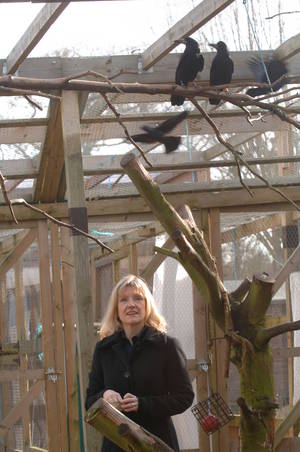
Chris - But why are you particularly interested in this family of animals?
Nicky - Well, these birds are particularly clever. We think of them as the feathered Einsteins or the feathered apes of the bird world. They have huge brains for their body size and there are all kinds of examples of just how clever they are.
Chris - One of the things you did recently was to see how good they were at planning for a rainy day, so tell us about that.
Nicky - Well, these birds hide food for the future. We call this caching behaviour, from the French word to hide. What we were interested in was the extent to which they could plan, because obviously other animals hide food, like squirrels, and many animals hibernate or migrate which means they have a forward looking behaviour. But there is a difference between a simple forward looking behaviour that might be triggered by a seasonal cue which will be entirely inborn and actually planning which would require some sort of thinking or forethought.
Chris - So how do you know they're actually doing that?
Nicky - So what we did was we asked whether they could plan for tomorrow's breakfast, and this is an experiment that was actually done by two of my Ph.D. students. It was led by Caroline Raby with help from Dean Alexis, and a member of my department Tony Dickinson, so credit must go to them as well as to me. What we did was to ask whether they could plan for tomorrow's breakfast, so we taught them that there were a suite of room that they could visit during the day.
Chris - Like a bird motel or something?
Nicky - That's right, a bird motel with a suite of three rooms and in the evening they went to sleep in the dark just as all birds do and when they woke up in the morning, they found themselves in one of two motel rooms. On some days they found themselves in motel room 1, they woke up hungry and breakfast was served, so no problem. On other days however, they found themselves in motel room 2, which was unlucky because when they woke up hungry as usual, there was no breakfast. But then all of a sudden, we gave them an unexpected test, which was to give them the opportunity to hide food as well as eat it in the evening and all the birds put the vast majority of the food, in motel room 2, where breakfast wasn't served.
Chris - So they knew that they had been hungry there in the past so they were relying on this past experience to plan for tomorrow because they may be in motel room 2 and have no food.
Nicky - Exactly, but they hadn't been trained to hide food in either of these rooms, and they used their past experience about which rooms served breakfast in the morning and which didn't to solve a potential problem. They didn't know where they'd be in the morning, so just in case, they'd put the food in the room where breakfast isn't served.
Chris - Why do they have this trait, you can see why we might do that because we are a bit more complex than they are, but what benefit does it serve this family of birds to have this ability?
Nicky - Well, that's a very interesting question from a number of levels; my husband, Dr. Nathan Emery and I have suggested that intelligence has evolved independently in two very different groups of animals: Apes, which obviously includes us, and members of the crow family. We think that this is because in the wild they have similar problems to solve, and they evolved around the same time as apes (around 5 million years ago), they are also highly social. One of the major theories formulated by Nicholas Humphrey is that the reason why we and other apes are so intelligent is because we live complex social lives. This is not just about living in a big group, but having to keep track of who does what to you and being able to network and do politics. The argument is that, those are exactly the type of problems that the members of the crow family solve.
Chris - I saw this piece in the Daily Telegraph this week, it says: "A quick smoke is good for the wings. Birds are picking up discarded cigarette butts and using their smoke to fumigate their wings of parasites, experts have suggested. Rooks have been spotted swooping onto the tracks at Exeter St. David's railway station in Devon and then placing their wings over the smoke to collect the fumes. One commuter said: I noticed the rooks because they are not usually found in towns. They were generally flapping about when a chap flicked a cigarette butt onto the track. It was still alight, and one of the rooks swooped down, picked the butt up with its beak and they flew around and landed on the platform dancing around with a cigarette butt in its beak. It looked quite comical, but then it dropped the butt onto the platform, placed its wings over it, collecting the smoke. It seemed as though it was using it to get rid of something, like an ant or a parasite or something." And then they got a quote from someone at the RCPB who said they've never heard about it but perhaps they'd learn to use the cigarette smoke to kill off parasites.
Nicky - How very clever, I've got to go and see them. I've never seen that but of course rooks are renowned for doing a number of very innovative and seemingly clever things. One of the most famous examples is that a couple of years ago they won the award for BBC's cleverest animal. This was rooks on one of the M4 motorway service stations, and what the birds were doing was finding a very innovative way of getting food that was at the bottom of the rubbish bins on the service station. So two birds would sit in tandem on the opposite ends of the rubbish bin, and slowly pull up the bin-liner under their feet. They would do it in tandem so that all the food would go to the middle where it's within beak's reach and then one bird would start tossing the food over the side while the other bird popped down onto the pavement to guard the food so it couldn't be stolen by others.
Chris - And because no one has ever shown them how to do that, they've had to work that out for themselves and then teach each other, so one has had to look at what the other one is doing to work out how to do it?
Nicky - Well I guess the million dollar question is whether each individual bird works it out for themselves and it just so happens that lots of them do it, or whether they are actually learning from one another. That's very interesting and it's one of the kinds of experiments that we are starting to do at Cambridge University; to look at whether the rooks will learn from one another and whether you could actually get mini cultures depending of which individual bird is learning to do things in a particular way.
Kat - I think one of the most fascinating things that have come out of bird research recently is that they use tools, because you can associate humans or Chimps with using tools, but birds have beaks so why do they need to use tools? So tell us a bit about tool usage in birds.
Nicky - Well, your beak can only go so far, just in the same way that if there is a small hole, you can't get your hand in there, it may also be that the hole is sufficiently small or deep that the food is out of beak's reach and that's when you'd need a tool. There are a number of species of birds that use tools, but the most remarkable thing is that one member of the crow family, the New Caledonia crow actually makes tools. So this sort of puts in on par with chimpanzees; they don't just use tools, they actually manufacture them, and they make different types of tools for different purposes.
Chris - Is there any clue given to us if you look at the animal's brains as to why these birds have these spectacular abilities compared with other animal that don't perform like this?
Nicky - Well if you look at the relative brain size, then obviously we have the biggest relative brain, but if you look at the next ones down it's the dolphins, but it's also the apes within the mammals and in the birds there are two groups, the crows and the parrots. If you look at where the enlargement is in the brain, just as in apes the enlargement is in the neocortex the same is true for the crows, the enlargement is in the avian neocortical area. So the same part of the brain is enlarged.
Chris - Thanks Nicky. That's Nicky Clayton from Cambridge University who works on Scrub jays and trying to use them to get insight into how they plan for the future and perhaps how our brains work too.

26:25 - Ozone Hole Revisited
Ozone Hole Revisited
with Jonathan Shanklin, British Antarctic Survey
It was a great pleasure to introduce to the show from the British Antarctic Survey, one of the team who first discovered the hole in the ozone layer in the mid 1980's: Jonathan Shankin. Chris - What is the ozone layer, and where is it?Jonathan - The ozone layer is high up in the atmosphere, from about 10 to maybe 30 kilometres. If you brought all the ozone in that layer down to the surface, you would have just 3 mm of pure ozone gas, but that 3mm is spread through maybe 20km of atmosphere, so even in the ozone layer there's not much ozone.Chris - So it's very thin, isn't it?Jonathan - It is very thin, and the worry that we have for the Antarctic is that during the Antarctic spring we have a hole in the ozone layer.Chris - How did you actually discover that the hole was there, what were you actually doing that enabled you to make that finding?Jonathan - We were actually making routine measurements of ozone. They started in the international geophysical year 1957-58 and we've been making them ever since. Really, the work was looking not to show that there's anything wrong with the ozone layer, we were trying to show that it was okay, that spray cans weren't destroying it, Concorde wasn't destroying it. We spotted that, during the Antarctic spring, ozone levels were dropping. We followed that up and found that it was a systematic change; it was different each year, getting lower and lower. That was published in Nature, the Americans went back to their satellite data and said, "Oh, whoops, you're right, we missed it."Chris - Why spring? What's the significance of the season?Jonathan - The significance of spring is really why it's over Antarctica. It's to do with the temperature high in the atmosphere. Once you get up to 14-20km, temperatures get to below -80 Celsius. At that sort of temperature, you get clouds forming in the ozone layer. Chemical reactions can occur on the surface of those clouds that convert the chlorine and bromine from halons into an active form, chlorine monoxide or bromine monoxide, and then when the sun returns in the arctic spring you get very efficient catalytic cycles that convert ozone back into oxygen. A molecule of oxygen has two atoms of oxygen, ozone has three atoms, and we get about 1% per day being converted back into oxygen.Chris - So what's the significance of the spray cans, what do they contribute, and also why just Antarctica, why not the North pole?Jonathan - The spray cans used to be powered by chlorofluorocarbons (CFCs) as a propellant, it was also found in upholstery foams, in plastic cartons and a whole host of exciting uses. They were mostly released in the northern hemisphere, but the process of diffusion means they get well mixed throughout the atmosphere. Roughly speaking, the concentration of CFCs at the South pole and the North pole are exactly the same, but what is different is the temperature. Over the Antarctic, every winter it's cold enough to form these stratospheric clouds high up in the atmosphere, but for the Arctic, it's only exceptionally cold winters due to the circulation of the atmosphere that enables these clouds to form. By and large, the Northern Hemisphere circulation is more complex, the atmosphere is better mixed and it's about 10 degrees warmer, so these clouds are quite rare. But they have been seen over Cambridge.Chris - So why doesn't the ozone from elsewhere in the atmosphere just flow in to Antarctica and replace the deficit, filling the hole?Jonathan - Essentially it can't. During the Antarctic winter you get very strong circumpolar circulation - called a polar vortex. That effectively acts as a barrier, it stops the air mixing from out of the Antarctic into the Antarctic. So what happens is during the spring you get a build up of ozone rich air around the Antarctic, in the middle you get very low levels of ozone, and that's the ozone hole.Kat - I would just like to backtrack a bit and ask why is the ozone layer so important, does it really matter if it's vanished? Can't we just take the ozone from down at street level and shove it back up there?Jonathan - It does matter if it disappears, what happens is that more ultra-violet (UV) light from the sun can get through to the surface when there's less ozone. This UV light can trigger skin cancers, cataracts and genetic damage in micro-organisms. So it's not very good for us to have too much UV. For example when we have the ozone hole in the Antarctic, you can get burned in 5 minutes if you don't put on factor 30 sun block.Kat - Wow. How is it actually linked in to global warming, which is something that we're becoming increasingly aware of?Jonathan - It's quite a complex thing. The ozone hole is actually completely separate in many ways from global warming, but global warming actually makes the ozone hole worse. That's because greenhouse gases act like a blanket, and though the surface of the Earth is heating up, the ozone layer is actually getting colder. The fact that it's getting colder means that more of those clouds can form, then more ozone destruction means it gets colder still, and it's a positive feedback cycle.Chris - Have the mechanisms we've put in place to try to limit the use of the agents, the CFCs that we think are responsible, actually worked? Is the hole shrinking?Jonathan - There's a big international treaty called the Montreal protocol, and all bar one of the worlds countries have signed up to the basic thing, so that's really good news. The amounts of these ozone-damaging things in the atmosphere are actually going down, so were definitely getting there with this one. But it is a symptom and not a thing in itself, and unless we tackle at a basic level what's causing many of these environmental problems, things can only get worse.Chris - Just to crystallise this in people's minds; how big is that hole over Antarctica?Jonathan - The Antarctic is 50 times the size of the UK, the ozone hole is bigger than that. Not by much but it gives you an idea.Chris - So at least fifty times the size of out own nation, it's quite a sobering thought.Jonathan - It is, and something we created entirely off our own bat.Chris - In actually quite a short space of time.Jonathan - In as little as 10 years. It shows you how fragile our atmosphere is, and how much care we need to take in case something similar happens in the future.
Chris - What is the ozone layer, and where is it?Jonathan - The ozone layer is high up in the atmosphere, from about 10 to maybe 30 kilometres. If you brought all the ozone in that layer down to the surface, you would have just 3 mm of pure ozone gas, but that 3mm is spread through maybe 20km of atmosphere, so even in the ozone layer there's not much ozone.Chris - So it's very thin, isn't it?Jonathan - It is very thin, and the worry that we have for the Antarctic is that during the Antarctic spring we have a hole in the ozone layer.Chris - How did you actually discover that the hole was there, what were you actually doing that enabled you to make that finding?Jonathan - We were actually making routine measurements of ozone. They started in the international geophysical year 1957-58 and we've been making them ever since. Really, the work was looking not to show that there's anything wrong with the ozone layer, we were trying to show that it was okay, that spray cans weren't destroying it, Concorde wasn't destroying it. We spotted that, during the Antarctic spring, ozone levels were dropping. We followed that up and found that it was a systematic change; it was different each year, getting lower and lower. That was published in Nature, the Americans went back to their satellite data and said, "Oh, whoops, you're right, we missed it."Chris - Why spring? What's the significance of the season?Jonathan - The significance of spring is really why it's over Antarctica. It's to do with the temperature high in the atmosphere. Once you get up to 14-20km, temperatures get to below -80 Celsius. At that sort of temperature, you get clouds forming in the ozone layer. Chemical reactions can occur on the surface of those clouds that convert the chlorine and bromine from halons into an active form, chlorine monoxide or bromine monoxide, and then when the sun returns in the arctic spring you get very efficient catalytic cycles that convert ozone back into oxygen. A molecule of oxygen has two atoms of oxygen, ozone has three atoms, and we get about 1% per day being converted back into oxygen.Chris - So what's the significance of the spray cans, what do they contribute, and also why just Antarctica, why not the North pole?Jonathan - The spray cans used to be powered by chlorofluorocarbons (CFCs) as a propellant, it was also found in upholstery foams, in plastic cartons and a whole host of exciting uses. They were mostly released in the northern hemisphere, but the process of diffusion means they get well mixed throughout the atmosphere. Roughly speaking, the concentration of CFCs at the South pole and the North pole are exactly the same, but what is different is the temperature. Over the Antarctic, every winter it's cold enough to form these stratospheric clouds high up in the atmosphere, but for the Arctic, it's only exceptionally cold winters due to the circulation of the atmosphere that enables these clouds to form. By and large, the Northern Hemisphere circulation is more complex, the atmosphere is better mixed and it's about 10 degrees warmer, so these clouds are quite rare. But they have been seen over Cambridge.Chris - So why doesn't the ozone from elsewhere in the atmosphere just flow in to Antarctica and replace the deficit, filling the hole?Jonathan - Essentially it can't. During the Antarctic winter you get very strong circumpolar circulation - called a polar vortex. That effectively acts as a barrier, it stops the air mixing from out of the Antarctic into the Antarctic. So what happens is during the spring you get a build up of ozone rich air around the Antarctic, in the middle you get very low levels of ozone, and that's the ozone hole.Kat - I would just like to backtrack a bit and ask why is the ozone layer so important, does it really matter if it's vanished? Can't we just take the ozone from down at street level and shove it back up there?Jonathan - It does matter if it disappears, what happens is that more ultra-violet (UV) light from the sun can get through to the surface when there's less ozone. This UV light can trigger skin cancers, cataracts and genetic damage in micro-organisms. So it's not very good for us to have too much UV. For example when we have the ozone hole in the Antarctic, you can get burned in 5 minutes if you don't put on factor 30 sun block.Kat - Wow. How is it actually linked in to global warming, which is something that we're becoming increasingly aware of?Jonathan - It's quite a complex thing. The ozone hole is actually completely separate in many ways from global warming, but global warming actually makes the ozone hole worse. That's because greenhouse gases act like a blanket, and though the surface of the Earth is heating up, the ozone layer is actually getting colder. The fact that it's getting colder means that more of those clouds can form, then more ozone destruction means it gets colder still, and it's a positive feedback cycle.Chris - Have the mechanisms we've put in place to try to limit the use of the agents, the CFCs that we think are responsible, actually worked? Is the hole shrinking?Jonathan - There's a big international treaty called the Montreal protocol, and all bar one of the worlds countries have signed up to the basic thing, so that's really good news. The amounts of these ozone-damaging things in the atmosphere are actually going down, so were definitely getting there with this one. But it is a symptom and not a thing in itself, and unless we tackle at a basic level what's causing many of these environmental problems, things can only get worse.Chris - Just to crystallise this in people's minds; how big is that hole over Antarctica?Jonathan - The Antarctic is 50 times the size of the UK, the ozone hole is bigger than that. Not by much but it gives you an idea.Chris - So at least fifty times the size of out own nation, it's quite a sobering thought.Jonathan - It is, and something we created entirely off our own bat.Chris - In actually quite a short space of time.Jonathan - In as little as 10 years. It shows you how fragile our atmosphere is, and how much care we need to take in case something similar happens in the future.
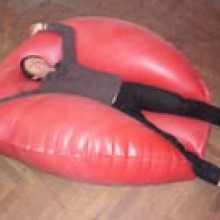
Record Breaking Whoopee Cushions
with Professor Trevor Cox, University of Salford
Chris - Let's get this out of the way to start with: why have you made the world's biggest whoopee cushion?
Trevor - A couple of weeks back I presented a science show at the Royal Albert Hall. Over the two shows we presented to 5000 kids a piece of science to try and make them interested in acoustics in general and science more broadly. The whole thing was call Beautiful Music, Horrible Sounds, and a whoopee cushion actually behaves like a musical instrument, so it was an excuse to make a giant whoopee cushion.
Chris - When you say that it plays like a musical instrument, you'll have to explain that a little bit more. It doesn't sound like a kind of Beethoven definition.
Trevor - No, it probably doesn't, but the mouth pieces of wind instruments such as trumpets and actually your vocal cords, all behave using the same science as a whoopee cushion, which is the Bernoulli effect. We were talking about the Bernoulli effect with the kids and we needed something big and impressive because this show was at the Royal Albert Hall, so every prop had to be massive. We built the world's largest whoopee cushion.
Chris - Now Trevor, your research is in the science of acoustics and you talk about big halls and things. So tell us a bit about big halls and how they can be built better to render sound, and what happens when you play sounds in certain environments.
Trevor - If you think about playing a sound outside, the sound is rather dry. You might have been to a classical concert where you have your picnic and the fireworks going off. You have a dry sound because all that's coming off is from the orchestra. When you go indoors, what you get is all the reflections from the walls and the ceiling and the floor. That enriches the sound and gives you a much richer experience. I suppose the most obvious effect is from reverberance, the thing you can hear in cathedrals as the sound echoes round.
Chris - Now you were kind enough to send me a bit of a sample of that, so I can try and play it. Talk us through what we're expecting to hear with this one with reverberation on it.
Trevor - Well this is actually played in a hall and is a bit of Tchaikovsky's 4th. You should hear quite a rich sound as you would normally expect from a concert [music].
Chris - Sounds good.
Trevor - Now the other piece you've got is actually played outside the hall. Imagine it being played on a snowy day, when there are no reflections at all. It was actually played in a special chamber called an anechoic chamber, and you'll notice that it's very very dry. This is the sort of sound you'd get from outdoor concerts [music].
Chris - Sounds totally different doesn't it. I suppose it goes without saying that it's the environment that makes the concert.
Trevor - Well it's part of it. Of course musicians are probably the most important part, and there are things like trying to get to your seat without getting wet walking from the car park. It's all very important, including the seat being comfortable.
Kat - My sister used to be a tour guide at the Albert Hall. Now they have all these little mushrooms in the ceiling, don't they? She said that they were put in because the echo was so incredible that a review of a concert in the Albert Hall when it was first built said 'this represents the best value for money as you can here two concerts: one three seconds after the other!' What do those sort of mushrooms and baffles do?
Trevor - If you're not familiar with the Albert Hall, what it's got is a great big dome on the ceiling. This focuses sound a bit like a concave mirror that you use for shaving. What you get is very strong reflection off these domes into certain places in the audience. It's so big and the delays are so long that you actually hear multiple sounds. You can hear the trumpets more than once; you can hear people talking more than once. The idea of the mushrooms is that they hang down below the dome, so you can't really see the dome in the Albert Hall very well. They just stop the stop the sound from getting into the dome and shorten reflection paths and reduce the echo problem.
Chris - Now if you go to the station and I try to understand the announcements, it's almost impossible. Why are stations so bad for things like echoes?
Trevor - Well a lot of the big famous stations, such as Paddington, are such vast spaces. So you've got these reflections from the ceilings and the walls taking a long time to reach you. What literally happens is that your ear decodes them as separate sound sources. If these reflections arrive early enough, your ear will just interpret them as all being from the same sound. That's the reason why when we're in a normal room, we don't get confused by all this sound echoing round us. We feel as though it's all coming from one source. But as soon as the sounds are delayed because the room is too large, we then start hearing multiple sources. Once you hear multiple sources and words start running into each other, it's very difficult to hear announcements.
Chris - One of things you made headlines for a few years ago was proving that ducks quacks echo, even though there's an urban legend saying that they don't.
Trevor - Yes, I did try to find the source of this myth because it was bugging me. If there's anyone listening now that knows where it comes from, let me know. But for some reason, you get these phrases that people recount as science fact, even though they're wrong. The phrase was that a duck's quack doesn't echo and no-one knows the reason why. We were contacted by a few media organisations asking whether it was true, and we thought we out to do something to dispel this myth. Any sound echoes, but it might be that in the case of the duck, they're very hard to hear.
Chris - And you actually proved that. What was her name, the duck that featured?
Trevor - The duck who featured originally was called Daisy, but unfortunately poor old Daisy's been eaten by a fox now.
Chris - So her echo certainly doesn't quack any more.
Trevor - No. We filmed it for a channel, and it was the daughter of Daisy who was very temperamental and vicious for a duck, I can tell you!
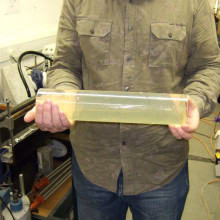
How fat would you have to be to stop a bullet?
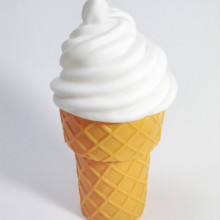
Why you get brain freeze or "ice cream headache" when you drink an icy or cold drink. ?
No-one knows precisely why this is, but people think that it is a form of referred pain.
Referred pain means that you have damage or pain coming from somewhere in your body but you feel it somewhere else.
People who have a heart attack often report feeling pain in their neck or in their left arm - not where their heart is. So in the same way as that, you've got your nervous system fooled into thinking that the pain's coming from somewhere else.
What scientists think is that the nerves in the mouth that are very sensitive to cold temperature accidentally trigger the nerves supplying the front of your head. It then thinks that there's a painful stimulus coming from there, when it's actually coming from your mouth. Another possibility is that when you put very cold things into your mouth, there's a nerve reflex to do with regulating heat and blood flow through your face and head.
It might be that when you put something cold onto the nerves that signal this reflex, it goes into overdrive and the blood vessels temporarily open too much because they think your head is freezing cold. In the same way that a migraine will give you that horrible throbbing headache, perhaps that's why you get that temporary pain right at the front of your head.
Why don't your eyeballs freeze?
[We put this question to David Thomas, author of 'Surviving Antarctica']Because your eyeball is contained within your head, and your head is kept at body temperature, it never gets cold enough to freeze. The eyeballs in a dead body would indeed freeze, but while you're alive and radiating heat it can't. Even tears wont freeze immediately, as they are very salty, and salt reduces the freezing point.
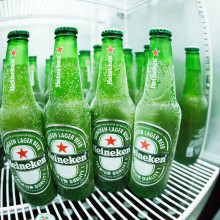
50:04 - Why does hitting the top of a beer bottle make the beer foam out like a volcano?
Why does hitting the top of a beer bottle make the beer foam out like a volcano?
This is similar to a question we had a few weeks ago when we were asked why it is that when a can of fizzy drink falls out of the dispenser, it doesn't explode when you open it. Dave and I discussed it and thought that when the can falls, it tends to spin. It lands on its side with the liquid spinning in a circle inside the can rather than striking the top of the can. Because the inside of the can is very smooth, the fluid doesn't come into contact with many rough surfaces and so there is nowhere for the gas to nucleate and form tiny bubbles. What could be going on in the beer bottle is that once the bottle is open, there is no pressure inside. The gas dissolved in the beer wants to come out as bobbles. If you smash the top of the bottle with another bottle, it makes a shock wave and I think that that would be sufficient to start some nucleation inside the drink. Once you have one bubble, it provides a site for other bubbles to form on. The whole thing feeds back on itself. As the bottle has a narrow neck, as soon as you have some bubbles it fills up and suddenly doesn't have anywhere to expand to. This pushes everything out in a massive volcano.
Why does helium make your voice sound funny?
The way your voice works is that your vocal chords vibrate and make a series of different frequencies. Your throat and mouth act as a resonant cavity. This is a bit like a tray of water, you can vibrate it at lots of different frequencies and not much will happen, but if you vibrate it at the same speed as a wave will travel up and down it, the wave will get stronger and stronger. Similarly if you vibrate your throat at the right speed the vibration will get stronger and stronger so you throat will amplify some of the frequencies your vocal chords are making (by changing the shape of your mouth you can alter which ones are strengthened which is how you make different vowel sounds). Sound travels faster in helium so the vibrations will get from your vocal chords to your mouth quicker so your throat will resonate at a higher frequency and hence a higher pitch. WARNING - There is no oxygen in a helium balloon and your body has no way of detecting that it is short on oxygen so you will feel fine until you fall unconconcious. So it is recommended you don't try and replicate this. If you must have a go, don't take deep breaths of helium or more than one breath of helium every few minutes.
- Previous Naked Science Q&A
- Next The Best of the Naked Scientists
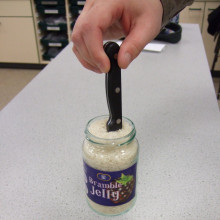










Comments
Add a comment